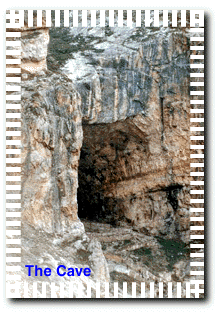![]()
|
The Holy Amarnath Situated in a narrow gorge at the farther end of Lidder valley, Amarnath stands at 3,888 m and is 44.8 km from Pahalgam and 141 km from Srinagar. Though the original pilgrimage subscribes that the yatra be undertaken from Srinagar, the more common practise is to begin journey at Pahalgam, and cover the distance to Amarnath and back in five days. Pahalgam is 96 km from Srinagar. Legend has it that Shiva recounted to Parvati the secret of creation in a cave in Amarnath. Unknown to them, a pair of mating doves eavesdropped on this conversation and having learned the secret, are reborn again and again, and have made the cave their eternal abode. Many pilgrims report seeing the dove-pair when they trek the arduous route to pay obeisance before the ice-lingam (the phallic symbol of Shiva). The trek to Amarnath, in the month of Shravan (July-August) has the devout flock to this incredible shrine, where the image of Shiva, in the form of a lingam, is formed naturally of an ice-stalagmite, and which waxes and wanes with the moon. By its side are, fascinatingly, two more ice-lingams, that of Parvati, and of their son, Ganesha. According to an ancient tale, there was once a Muslim shepherd named Buta Malik who was given a sack of coal by a sadhu. Upon reaching home he discovered that the sack, in fact, contained gold. Overjoyed and overcome, Buta Malik rushed back to look for the sadhu and thank him, but on the spot of their meeting discovered a cave, and eventually this became a place of pilgrimage for all believers. To date, a percentage of the donations made by pilgrims are given to the descendants of Malik and the remaining to the trust which manages the shrine. Yet another legend has it that when Kashyap Reshi drained the Kashmir valley of water (it was believed to have been a vast lake), the cave and the lingam were discovered by Bregish Reshi who was travelling the Himalayas. When people heard of the lingam, Amarnath for them became Shiva's abode and a center of pilgrimage. Whatever the legends and the history of Amarnath's discovery, it is today an extremely crucial centre of pilgrimage, and though the route is as difficult to trespass as it is exciting, every annum, millions of devotees from the subcontinent come to pay homage before Shiva in one of his Himalayan abodes. The Pilgrimage
The trek from Pahalgam to Amarnath cave is on an ancient peregrine route. The 45-km distance is covered in four days, with night halts at Chandanwari, Sheshnag (Wawjan) and Panchtarni. The distance from Pahalgam to Chandanwari (12.8 km) is covered in about five to six hours, and the trail runs along the Lidder river. Pilgrims camp here on the first night out. A major attraction here is a bridge covered, year round, with ice even though the surroundings are free from it. The next day's trek, of 13 km, is through spectacular, primeval countryside, and the main centre of attraction is Sheshnag, a mountain which derives its name from its seven peaks, resembling the heads of a mythical snake. The journey to Sheshnag follows steep inclines up the right bank of a cascading stream and wild scenery untouched by civilization. The second night's camp at Wawjan overlooks the deep blue waters of Sheshnag lake, and glaciers beyond it. There are legends of love and revenge too associated with Sheshnag, and at the camp these are recounted by campfires, to the stillness of a pine-scented, Himalayan night. The third day's 13 km trek steadily gains height, winding up across Mahagunas Pass at 4,600 m and then descending to the meadow-lands of Panchtarni, the last camp enroute to the holy cave. From Panchtarni to Amarnath is only 6 km, but an early morning's start is recommended for there is a long queue awaiting entrance to the cave. The same day, following darshan, devotees can return to Panchtarni in time for lunch, and continue to Wawjan to spend the fourth night out; or continue further to Zojibal, returning to Pahalgam on the fifth day. The devotees sing bhajans, chant incantations, and priests petform aarti and puja, invoking the blessings of Shiva, the divine, the pure, the absolute. For those who journey with faith, it is a rewarding experience, this simple visitation to a cave-shrine, the home of the Himalayan mendicant who is both destroyer and healer, the greatest of the Hindu deities. Of all the pilgrimages, the pilgrimage to the holy cave of Amarnath, a shrine of Lord Shiva, high up in the ranges of the Himalayas, is considered as one of the most sacred and captivating practice. It is an event that tends to awaken the divinity embedded in the deep recesses of man's mind, and he feels a soft and serene impact of the Great Spirit. Recalling Swami Vivekananda's experience at the holy cave, sister Nivedita wrote: "Never had Swami felt such a spiritual exaltation. So saturated had he become with the presence of the Great God that for days after he could speak of nothing else. Shiva was all in all; Shiva, the eternal one, the great monk, rapt in meditation, aloof from the world." Later on, Swami Vivekananda himself recounted: "I have never been to anything so beautiful, so inspiring." Such is the impression that the Amarnath Yatra leaves on the minds of most of the yatris. After traveling on foot or horse on one of the most enchanting and enthralling routes in the world, which itself transmits a feeling of being "upward and divine," the yatri sees the "ice-lingam" in all its shining glory and greatness, and experiences the impact of an invisible, yet all-pervading, an incomprehensible, yet all-conveying, force of "what was, is and will be." In a state of heightened sublimity and with his faith fully surcharged and the awe and majesty of the sights around him, the yatri perceives, with his mind's eye, Lord Shiva, sitting calmly underneath an imperishable, canopy, provided by the "mount of immortality" and conveying in hushed silence the message of inseparability of the processes of creation and destruction; of "every beginning having an end, and every end having a beginning." "Amarnath" means Deathless GodLord Shiva. He is the God of gods, Mahadeva, about whom Bhishma says in the Mahabharat "I am incapable of enunciating the attributes of the wise Mahadeva, who is ubiquitous but nowhere visible; who is the creator of Brahma, Vishnu, and Indra and their lord as well; whom all the deities from Brahma to the Pisachas worship; who transcends all natural phenomena as well as the absolute spirit whom the rishis who practice discipline and have arrived at truth contemplate; who is indestructible, supreme, the Brahman himself; who does not exist and yet exists." The holy cave is located in one of the "purest and firmest' peaks of the Himalayas which, in the Hindu tradition, is itself a symbol of sublimity, serenity and strength. And there is a very close relationship between these "silvery mountains" and Lord Shiva. This relationship finds best expression in the words of Sankara, when overwhelmed by the physical and spiritual beauty of the white peaks, he reflected: "Oh Shiva. Thy body is white, white is Thy smile, the human skull in Thy hand is white. Thy axe, Thy bill, Thy earrings all are white. The Ganga flowing out in foams from your matted locks, is white. The crescent moon on Thy brow is white. Oh all-white Shiva, give us the boon of complete sinlessness in our lives." Kalidas described the Himalayas as "the laughter of Shiva." Sri Krishna also said in the Bhagavad Gita: "Of the mountains, I am the Himalayas." When asked why India had so many gods and goddesses, Swami Vivekananda replied: "Because we have the Himalayas." The cave is accessible only during a short period of a year, usually in the months of July and August. At that time, inside the cave, a pure white ice-lingam comes into being. Water trickles, somewhat mysteriously, in slow rhythm, from the top of the cave and freezes into ice. It first forms a solid base and then on it a lingam begins to rise, almost imperceptibly, and acquires full form on Purnima. It is believed that on that day, Lord Shiva revealed the secrets of life to his consort Parvati, the beautiful daughter of the Himalayas.
The present Kashmir valley, according to Nilamata Purana, was once a huge lake, known as Satidesa. It was surrounded by high mountains. To kill a demon, called Jalodhbava, who was "indestructible under water." Rishi Kashyap, with the blessings of Brahma, Vishnu and Shiva, made a cut in the mountains and drained off water. The land that emerged began to be inhabited and came to be called Kashmir, after Rishi Kashyap. At a few spots of rare beauty and seclusion, saints and gods carved out their hermitages, for meditation. The Yatra, in its present religious form, commences with the ceremony of "Chari Mubarak," at the Dashnami temple, Akhara, Srinagar. After the prayers, the yatri acquires a sort of walking stick. It has both physical and religious significance; physically, it helps the yatri in steadying himself on a snowy and slippery path; and, spiritually, it reminds him of his resolve at the temple if and when his faith begins to waver in the face of a long and arduous journey. After the ceremony, the yatris proceed in groups to Pahalgam, from where a small road leads to Chandanwari, along thick and green woodlands of breathtaking beauty, perched on pretty rocks and little hills, with the playful stream of Lidder meandering and dancing in-between, showing its white-foam sparkle with the pride and purity of a maiden descending directly from the lap of the perennial Himalayas. From Chandanwari, there begins a steep ascent to Pishu Ghati (3,171 meters), reminding the yatris that the path to salvation involves superhuman struggle and stamina. A feeling of having been lifted to a heavenly spot dawns upon the yatris when they reach Seshnag (3,570 meters)so striking is the beauty, the setting and the color of this great lake. Seshnag symbolizes the cosmic ocean in which Lord Vishnu, the preserver of this universe, moves, reclining on a seven-headed mythical snake. After getting refreshed with the bath of ice-cold water of Seshnag, the yatri takes a steep climb to the most difficult spot. Mahagunna (4,350 meters). Thereafter, a short descent begins to Poshpathan festooned with wild flowers. From there, the yatris move to Panchtarni, a confluence of five mythical streams, and then to the cave. A strange sense of fulfillment seizes the yatris, and all fatigue is forgotten. Even in the temperature touching zero degrees Celsius, the yatris are driven by their faith to take bath in the almost freezing rivulet of Amravati. The unique Yatra satisfies the individual's urge to take his soul to soaring heights, to experience spiritual passions of the highest order and see Mahadeva in His greatest image and in His finest abode. |
News | Culture | Economy | Sports | Tourism | Polity | Magazine | Info
Media | Science & Tech. | Social Issues | Foreign Relations | States
What's New | Search | Home


 It
is a mystery how the ice-lingam is formed on the ice-base, how it attains
its full formation and maximum height on the Purnima day and how a pair
of pigeons appears on the scene. Even the most skeptic mind is persuaded
to believe that all these occurrences could not be a mere coincidence.
It
is a mystery how the ice-lingam is formed on the ice-base, how it attains
its full formation and maximum height on the Purnima day and how a pair
of pigeons appears on the scene. Even the most skeptic mind is persuaded
to believe that all these occurrences could not be a mere coincidence.